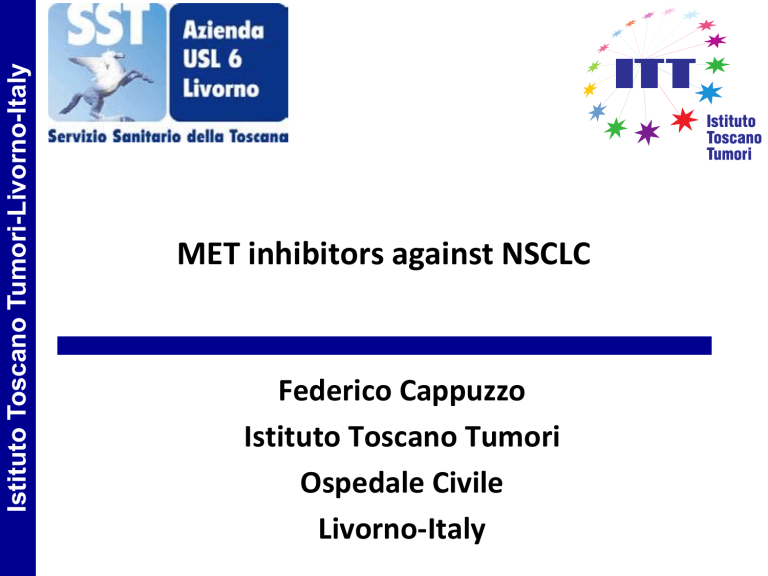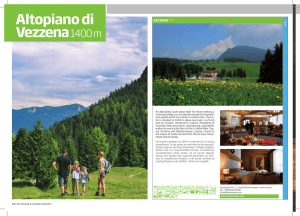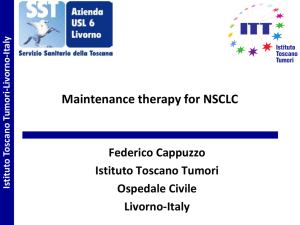
Istituto Toscano Tumori-Livorno-Italy
Aprile
MET inhibitors against NSCLC
Piano Generale di Emergenza
Federico Cappuzzo
PresidioIstituto
Ospedaliero
di Livorno
Toscano Tumori
Viale AlfieriOspedale
36 Civile
Livorno-Italy
Istituto Toscano Tumori-Livorno-Italy
MET Structure and Function
• MET is a receptor tyrosine kinase
• MET gene located on chromosome 7 (7q21–q31)
• Produces HGF receptor
– Single precursor protein
– Extracellular α-chain and transmembrane β-chain,
linked by disulfide bonds
• MET normally activated via ligation with its natural ligand
HGF
• Normal MET activation facilitates cell processes for
embryonic development, wound healing, and tissue
regeneration
Istituto Toscano Tumori-Livorno-Italy
MET dysregulation in NSCLC
MET abnormalities leading to dysregulated activation of
MET/HGF pathway:
– Protein overexpression
– Increased gene copy number (amplification)
– Mutations
– Aberrant splicing
Negative biologic effects result in malignancy and metastasis
Istituto Toscano Tumori-Livorno-Italy
MET expression in solid tumors
MET
p-MET
100%
90%
80%
70%
60%
50%
40%
30%
20%
10%
0%
Lung Cancer expresses
highest pMET among
common solid cancers
3
2
1
0
Lung
Ovary
Breast
Renal
Human Cancers
Colon
Istituto Toscano Tumori-Livorno-Italy
MET amplification in NSCLC
Total evaluated: 435
Low copy number:
383 (88.9%)
High polysomy:
30 (7.0%)
Gene amplification:
18 (4.1%)
Cappuzzo et al. J Clin Oncol 2009;27:1667–74.
Cumulative Survival
(proportion)
Istituto Toscano Tumori-Livorno-Italy
High MET Copy Number: Poor Prognosis in
Surgically Resected/Early Stage NSCLC
1.0
0.9
0.8
0.7
0.6
0.5
0.4
0.3
0.2
0.1
0
≥ 4 to < 5 copies/cell
< 2 copies/cell
≥ 3 to < 4 copies/cell
≥ 2 to < 3 copies/cell
≥ 6 copies/cell
≥ 5 to < 6 copies/cell
0
20
40
60
Time (months)
80
100
1.0
0.9
0.8
0.7
0.6
0.5
0.4
0.3
0.2
0.1
0
MET < 5 copies/cell
(n = 383)
MET ≥ 5 copies/cell
(n = 48)
P = .0045
0
20
40 60
80
Time (months)
100 120
Cappuzzo et al. J Clin Oncol 2009;27:1667–74.
Istituto Toscano Tumori-Livorno-Italy
Anti-MET agents in development in patients
with NSCLC
Agent
Target
Type
Development phase
Ligand antagonists
Ficlatuzumab (AV-299)
HGF
Monoclonal antibody
I and II
Rilotumumab (AMG-102)
HGF
Monoclonal antibody
II
TAK-701
HGF
Monoclonal antibody
I
MET
Monoclonal antibody
III completed
Tivantinib (ARQ-197)
MET
Non-ATP competitive TKI
III completed
Cabozantinib (XL-184)
MET, RET, VEGFR1-3,
KIT, FLT3, TIE2
MET, RON, VEGFR1-3,
PDGFR, KIT, FLT3, TIE2
MET, ALK
ATP competitive TKI
II
ATP competitive TKI
II
ATP competitive TKI
II and III
MET, RON, VEGFR1-2,
PDGFR, KIT, FLT3, TIE2
ATP competitive TKI
II
Receptor inhibitors
Onartuzumab (OA5D5)
Receptor TKIs
Foretinib (XL-880)
Crizotinib (PF-02341066)
MGCD-265
Istituto Toscano Tumori-Livorno-Italy
Co-inhibition of Met and EGF Receptors is More
Potent than Inhibiting Either Alone in an EGFR WT
NSCLC Model
In Vivo
In Vitro
NSCLC Lines
Erlotinib IC50 (μM)
TGFα
TGFα+HGF
H596
0.508
H596+MetMAb
>10
0.997
Control
H596: WT EGFR cell line
Met activation by HGF decreases sensitivity to erlotinib.
MetMAb restores sensitivity.
Combination of erlotinib+MetMAb exhibits robust activity.
Istituto Toscano Tumori-Livorno-Italy
Onartuzumab (MetMAb): Randomized Phase II
Trial
Onartuzumab (MetMAb): monovalent (single-arm) antibody to MET,
prevents MET activation by HGF
Previously treated advancedstage
NSCLC patients
N = 137*
MetMAb (15 mg/kg IV every 3 weeks)
+ Erlotinib (150 mg daily)
(n = 69)
Stratified by:
History of tabacco use,
ECOG PS, histology
Placebo (IV every 3 weeks)
+ Erlotinib (150 mg daily)
(n = 68)
PD*
*Includes 9 patients with squamous cell histology
†Patients in placebo arm allowed to cross-over to receive MetMAb (n = 27)
Primary endpoint: PFS in Met-positive and ITT population
Secondary endpoints: OS, ORR, safety
Spigel, et al. ASCO 2011. Abstract 7505.
Istituto Toscano Tumori-Livorno-Italy
Onartuzumab (MetMAb): MET Diagnostic IHC
Negative
Weak
Moderate
Strong
+
Spigel D, et al. ASCO 2011. Abstract 7505.
OS: HR = 0.37
PFS: HR = 0.53
Median (mo)
HR
(95% CI)
Log-rank p-value
No. of events
1.0
0.8
Placebo +
erlotinib
MetMAb +
erlotinib
1.5
2.9
Placebo +
erlotinib
0.53
(0.28-0.99)
0.04
27
20
Median (mo)
HR
(95% CI)
Log-rank p-value
No. of events
1.0
Probability of survival
Toscano Tumori-Livorno-Italy
Istituto
Probability of progression free
Onartuzumab (MetMAb): PFS and OS in MET
Dx+ (High-Positive) Population
0.6
0.4
0.2
0.0
0.8
MetMAb +
erlotinib
3.8
12.6
0.37
(0.19-0.72)
0.002
26
16
0.6
0.4
0.2
0.0
0
3
6
9
12
15
Time to progression (months)
18
0
3
6
9
12
15
Overall survival (months)
18
21
Spigel D, et al. ASCO 2011. Abstract 7505.
Istituto Toscano Tumori-Livorno-Italy
The prevalence of MET expression by
immunohistochemistry (IHC) in the METLung
(OAM4971g) trial: a randomized, placebocontrolled Phase III study with erlotinib + placebo
vs. erlotinib + onartuzumab (MetMAb) in patients
with previously treated NSCLC.
Martin J. Edelman1, David Spigel2, Kenneth O’Byrne3, Tony Mok4,
Wei Yu5, Simonetta Mocci5, Virginia Paton5, Luis Paz-Ares Rodriguez6
1Univeristy
of New Mexico Health Sciences Center, Albuquerque, NM USA; 2Sarah
Cannon Research Institute and Tennessee Oncology PLLC, Nashville, TN USA;
3Princess Alexandra Hospital, Brisbane, Australia; 4The Chinese University of Hong
Kong, Hong Kong; 5Genentech, Inc. South San Francisco, CA USA; 6Instituto de
Biomedicina de Sevilla (HUVR, US and CSIC) and Hospital Universitario Virgen del
Rocio, Seville, Spain
Istituto Toscano Tumori-Livorno-Italy
Onartuzumab (MetMAb) Phase III
2L/3L MET-positive NSCLC
2L and 3L NSCLC pts
Randomise
1:1
(1 prior Pt-based line)
Central testing for*:
• MET status
• EGFR mutation status
N = 490
erlotinib +
onartuzumab
Treatments:
• Tarceva 150 mg PO qd
• onartuzumab/placebo 15 mg/kg IV
q3wk
Treat
until
PD
erlotinib + placebo
No crossover tx
Key eligibility criteria:
• Stage IIIB or IV Met
diagnostic positive NSCLC
• 1-2 prior lines of tx
• No prior EGFR inhibitor
• ECOG PS 0 or 1
Stratification criteria:
• EGFR mut status
• MET 2+ or 3+
score
• # of prior lines of
tx
• Histology
*PRE-SCREENING: Patients could submit tumor samples for
testing prior to requiring treatment with 2L or 3L therapy
Primary endpoint:
• Overall survival (OS)
Secondary endpoints:
• Progression-free survival
(PFS)
• Overall response rate
(ORR)
• Quality of life (QoL)
• Safety
Patient Characteristics
Overall MET Status
Screened*
Age (n=1580)
Median (yrs)
Screened*
63.0
MET IHC Status (n=1587)
Race (n=1580)
White
1290 (82%)
Asian
179 (11%)
Other
111 ( 7%)
MET-positive
782 (49%)
MET-negative
805 (51%)
Sex (n=1580)
Male
991 (63%)
Histology (n=1552)
Non-Squamous
Squamous
1183 (76%)
MET IHC Score (n=1587)
3+
175 (11%)
2+
607 (38%)
1+
666 (42%)
0
139 ( 9%)
369 (24%)
EGFR Activating Mutation (n=1531)
Yes
122 ( 8%)
No
1409 (92%)
* Patients with valid MET results were summarized.
MET+ prevalence by Histology
n=1552
MET IHC Status
MET-positive
MET+ prevalence by EGFR status
Non-Squamous
n=1183
Squamous
n=369
n=1531
MET IHC Status
EGFR mut
n=122
Non EGFR mut
n=1409
655 (55%)
114 (31%)
MET-positive
74 (61%)
696 (49%)
*P<0.0001
*P=0.02
MET+ prevalence by Smoking History
n=1575
MET IHC Status
MET-positive
Never
n=260
Previous
n=997
Current
n=318
142 (55%)
496 (50%)
133 (42%)
*P=0.002 (vs Never)
*P=0.01 (vs Previous)
MET+ prevalence by Asian vs. ROW
n=1580
Met IHC Status
MET-positive
Asian
n=179
White
n=1290
Other
n=111
94 (53%)
611 (47%)
*P=0.2 (vs Asian)
71 (64%)
*Chi square test
Istituto Toscano Tumori-Livorno-Italy
Tivantinib (ARQ 197): a Novel and Selective
Tyrosine Kinase Inhibitor
• Non-ATP competitive inhibitor of
c-MET
• Novel mechanism of binding
stabilizes inactive conformation
of c-MET
• Compound demonstrates broad-spectrum, anti-tumor activity in a
number of tumor xenograft models (including NSCLC)
• In vivo anti-tumor activity of ARQ 197 + EGFR inhibitor greater
than either drug alone
• Demonstration of safety and linear PK in phase I combination with
EGFR inhibitor erlotinib
Istituto Toscano Tumori-Livorno-Italy
Tivantinib: Study Design
Randomized, placebo-controlled, double-blind clinical trial
NSCLC
• Inoperable locally adv/
metastatic dz.
• ≥1 prior chemo
(no prior EGFR TKI)
Endpoints
• 1° PFS
• 2° ORR, OS
• Subset analyses
• Crossover: ORR
R
A
N
D
O
M
I
Z
E
Erlotinib 150 mg PO QD
+ ARQ 197 360 mg PO BID
28-day cycle
PD
Erlotinib 150 mg PO QD
+ Placebo
28-day cycle
• 33 sites in 6 countries
• Study accrual over 11 months (10/08-9/09)
• Randomization stratified by prognostic factors incl. sex,
age, smoking, histology, performance status, prior
therapy and best response, and geography (U.S. vs. exU.S.)
Istituto Toscano Tumori-Livorno-Italy
Tivantinib: PFS in Histologic and Molecular
Subgroups
ARQ197/erlotinib
N
Placebo/erlotinib
Unadjusted HR (95% CI)
Median PFS (95% CI, weeks)
Squamous Cell
26 / 24
13.7 (8.0‒18.1)
8.4 (7.9‒21.0)
HR=1.05
Non-Squamous Cell
58 / 59
18.9 (15.0‒31.1)
9.7 (8.0‒16.0)
HR=0.71
c-MET FISH >4
19 / 18
15.4 (8.1‒24.4)
15.3 (7.1‒16.3)
HR=0.71
c-MET FISH >5
8 / 11
24.1 (16.3‒NE)
15.6 (7.9‒31.4)
HR=0.45
EGFR mutant
6 / 11
24.1 (8.0‒32.1)
21.0 (8.1‒36.0)
HR=1.23
EGFR wt
51 / 48
13.7 (8.1‒18.1)
8.1 (7.9‒9.9)
HR=0.70
KRAS mutant
10 / 5
9.7 (7.9‒NE)
4.3 (1.1‒8.0)
HR=0.18
KRAS wt
49 / 45
15.4 (8.1‒18.1)
9.9 (8.0‒16.0)
HR=1.01
0
0.5
1.0
Favors
ARQ 197/Erlotinib
1.5
2.0 5.0
Favors
Erlotinib/placebo
Istituto Toscano Tumori-Livorno-Italy
MARQUEE phase III study design
Primary end-point: OS
Istituto Toscano Tumori-Livorno-Italy
MARQUEE study biomarkers
Istituto Toscano Tumori-Livorno-Italy
MARQUEE: PFS in the study population
Istituto Toscano Tumori-Livorno-Italy
MARQUEE: OS in the study population
Istituto Toscano Tumori-Livorno-Italy
MARQUEE: PFS and OS in MET-
Istituto Toscano Tumori-Livorno-Italy
MARQUEE: PFS and OS in MET+
Istituto Toscano Tumori-Livorno-Italy
MARQUEE: Forest plot for OS in key subgroups
Istituto Toscano Tumori-Livorno-Italy
Foretinib (EXEL-2880): A MET and VEGFR2
Tyrosine Kinase Inhibitor
Pre-clinical evidence of efficacy[1]
Phase I/II (phase II is randomized erlotinib +/- foretinib) trial currently
ongoing[2]
1. Reprinted from Qian F, et al. Cancer Res. 2009;69:8009-8016, with permission from the AACR.
2. ClinicalTrials.gov. NCT01068587.
Istituto Toscano Tumori-Livorno-Italy
Biomarker Analysis of NCIC Clinical Trials
Group IND.196:
a Phase I Study of Erlotinib plus Foretinib in
patients with Advanced Pretreated NSCLC
Patients
NB Leighl, MS Tsao, G Liu, D Tu, Z Chen, S Sakashita, C Ho, FA
Shepherd, N Murray, J Goffin, G Nicholas, L Kim, S KamelReid, J Ho, T Zhang, NA Pham, M Sukhai, L Seymour, G Goss, PA
Bradbury
NCIC Clinical Trials Group, Kingston, Canada
NCIC CTG received trial support from GSK;
presenter and co-authors report no other conflicts
100
* No FORET # PR
Best % Tumour Shrinkage from Baseline
Istituto Toscano Tumori-Livorno-Italy
Erlotinib plus Foretinib: responses observed in
I196
EGFR mut+
and
in MET IHC+
(n = 27 evaluable patients)
80
MET+
60
K:WT
E:WT
40
*
20
K:WT
E:WT
0
K:Mut
E:WT
K:Mut
E:WT
K:Mut
E:WT
E:WT
K:WT
-20
#
#
-40
-60
#
-80
-100
#
#
E:Mut
K:WT
E:Mut
K:WT
E:WT E:Mut
K:WT K:WT
E:WT
K:Mut
Met: P AXL: P
Met: P AXL: N
Met: N AXL: P
Met: N AXL: N
Met: N AXL: NA
Met: NA AXL: P
Met: NA AXL: NA
Istituto Toscano Tumori-Livorno-Italy
Conclusions
• MET is a negative prognostic factor in NSCLC
• Several agents are under investigation
• MET overexpressing patients seem more sensitive to antiMET agents
• Efficacy in MET amplified/mutated patients is unknown
• Anti-MET strategies should be investigated in individuals
with EGFR mutations with acquired resistance to anti-EGFR
agents


